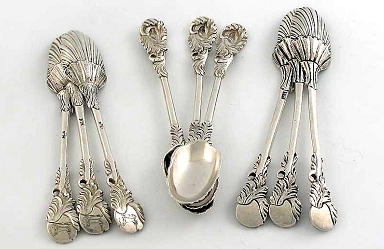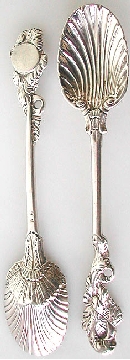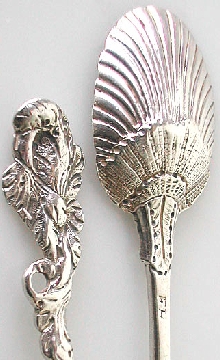My Gallery - Rococo Grand Pattern Silver Spoons
Gold teaspoons and a pair of tongs made by Francis Harrache, London, circa 1750. The Rosalinde and Arthur Gilbert Collection on loan to the Victoria and Albert Museum.This type of design is mentioned as "Rococo foliate" however it is not categorized as any specific pattern or type. These spoons epitomize Pure Rococo characteristics like S & C scrolls, shell, Acanthus leaf, asymmetry and rocaille in some cases rather Naturalism imitating a leaf as life. It gives me a noble and great impression.
So I would like to name this design "Rococo Grand" pattern.
The most important example of this pattern is a set of 6 gold teaspoons and a pair of tea tongs made by Francis Harrache in the Gilbert Collection. Those spoons each have a shell-shaped bowl, which is chased on the outside and plain on the inside, with a leaf molding chased on the lower frontjunction. The upper end of the stem is chased on both sides with foliage, scrolls, and shell motifs. The tea tongs are of scissor form, with similar bowls and decoration.
Eariest Version of Rococo Grand pattern teaspoons by Francis Harrache and John Derussat, circa late 1730s
 A set of six George II teaspoons, with shell bowls, scrolling leaf terminals, crested, by Francis Harrache, London, and three George II teaspoons of similar design, two unmarked, the other maker's mark 'IH', 4.2oz. Woolley & Wallis.Three teaspoons are marked with the crowned FH mark of Francis Harrache and three are marked JD with acorn above of John (I) Derussat. This set clearly shows that two of the most important silversmiths in the history of the Rococo Naturalistic spoon shared the earliest design of the Rococo Grand pattern, in the same Huguenots community at Soho area of London, late 1730s.
A set of six George II teaspoons, with shell bowls, scrolling leaf terminals, crested, by Francis Harrache, London, and three George II teaspoons of similar design, two unmarked, the other maker's mark 'IH', 4.2oz. Woolley & Wallis.Three teaspoons are marked with the crowned FH mark of Francis Harrache and three are marked JD with acorn above of John (I) Derussat. This set clearly shows that two of the most important silversmiths in the history of the Rococo Naturalistic spoon shared the earliest design of the Rococo Grand pattern, in the same Huguenots community at Soho area of London, late 1730s.
This design is nearly identical with more ellegant prototype design of Francis Harrache's gold teaspoons in the Gilbert collection. The same primitive design teaspoon by Jean Harrache was also recorderd. The six teaspoons match in design, however one spoon has a different design close to the bowl.
Length: 10.8cm and 11cm; Weight: 89grams.
Three spoons by Francis Harrache are slightly smaller in proportions, this fact implys that they were made earlier than three spoons by John (I) Derussat.
6 Rococo Grand pattern teaspoons by Francis Harrache
A set of six teaspoons made by Francis Harrache, circa 1750. The design is similar to his gold teaspoons in the Gilbert collection however the inside of the bowl is also chased as a shell-shape with scrolls on the front and Rocaille on the back of the lower junction.
Dimensions: 103mm long; 13g weight.
A Rococo Grand pattern silver-gilt teaspoon by Francis Harrache
This is a very rare silver-gilt Rococo Grand pattern teaspoon made by Francis Harrache, circa 1750. The design is very similar to the above however the joint part of the bowl and the stem is more delicately deorated.
Dimensions: 105mm long; 16g weight.


4 Rococo Grand pattern teaspoons by Francis Harrache
Set of four (originaly six) teaspoons made by Francis Harrache, circa 1750. The design is similar to his gold teaspoons in the Gilbert collection however far more sophisticated. Both sides of the bowl are casted as a shell shape with very delicate "rocaille" decoration on the back The end of the stem is left for the crest. This design is the most sophisticated among the Rococo Grand patterns.
Dimensions: 105 mm long; 14g weight.


Silver-gilt Rococo Grand pattern Moote Spoon, unmarked, circa 1740
This very finely chased silver-gilt moote spoon with a fluted and intricately pierced shell-shaped bowl with scrolls like Ionic capital on the front of the lower junction must be made as a part of an important tea equipage in mid-18 century. The lower end of the stem and the back of the bowl are decorated by delicate Arcanthus motievs.
A moote spoon in Rococo Grand pattern is extreamly rare and this is even the finest among them.
Dimesntions : 109mm, Weight 10gram.
A set of twelve George II silver-gilt Rococo teaspoons, unmarked circa 1740
A set of twelve George II silver-gilt Rococo teaspoons, unmarked circa 1740, the reverse of the bowls with shell decoration, the terminals with asymmetrical foliate decoration. These are made from a very good gauge of silver - surely top quality spoons. The decoration is very crisp throughout and the gilding remains intact.
One spoon (length:11.4cm, weight:25g) has a repair to the junction between bowl and stem. It shows as a flaw on the top rim of the bowl adjacent to one side of the handle and as a slightly raised lump on the back of the stem. It is not obvious and only observed under close viewing. The gilding covers it and it has been partially regilded or was a problem in manufacturing (n.b. the gilding colour matches the remainder of the set).
Length : 11.3-11.4cm
Weight : 23g * 3 spoons, 24g * 3 spoons, 25g * 3 spoons, 26g * 1 spoon, 27g * 1 spoon, 30g * 1 spoon.
The provenance of these spoons is the Albert Collection, in which these spoons are registered as entry number 155. These are illustrated in a book, Butler, R, The Albert Collection, Broadway Publishing 2004, page 234, which catalogues the important collection of silver that has been dispersed in about 2005. I purchased these at the auction at Woolley & Wallis (Sale SV280410) on 28 April 2010.
The design of these spoons is very similar to Francis Harrache's gold teaspoons in the Gilbert Collection, circa 1745. However these spoons have no decoration on the junction between the stem and the bowl, and its size (Length:11.4cm) is much bigger than Harrache's (Length:10.5cm) which means that the size of these spoons do not match with the standard size of tea cups made before late 1750s. And also Rococo foliate scroll work of the stem is bigger and the hole of the pierced "S"curve is burried with a small flower. Its stem is thicker and has a straight pillar-shaped ornament on the front side, which gives strong impression very different from usual Rococo taste.
However this is really down to the specifications of the original commission. These spoons would have cost more than standard examples and so were probably ordered by a wealthier client. The client would have discussed the spoons' design with the silversmith and a pattern book would probably have been consulted. This does not mean that variations from the standard patterns would not have been possible. A separate casting mould would have been necessary, however the sand casting moulds used in those days would have been short lived and that will be the reason for so many designs. It is perhaps possible that in this particular instance that the central pillar section was in fact not cast and that the cast foliate Rococo scrol leafy terminals and bowls were added to each end (also perhaps accounting for the flaw).
Such a commission would only have been entrusted to a London based maker and therefore it would be highly doubtful the possibility of a provincial manufacture. One of the top specialists in this field would have been responsible for their making and Francis Harache would be at the top of list of possibilities.
It is interesting that weight of each spoon varies so much, from 23g to 30g. The difference in weight between the spoons would be due to the stem construction as mentioned above. It would have been the reason (are there perhaps different thicknesses between the stems).
These facts make this set of spoons very special example in 1740s.
 Top
Top Site Map
Site Map References
References About Me
About Me